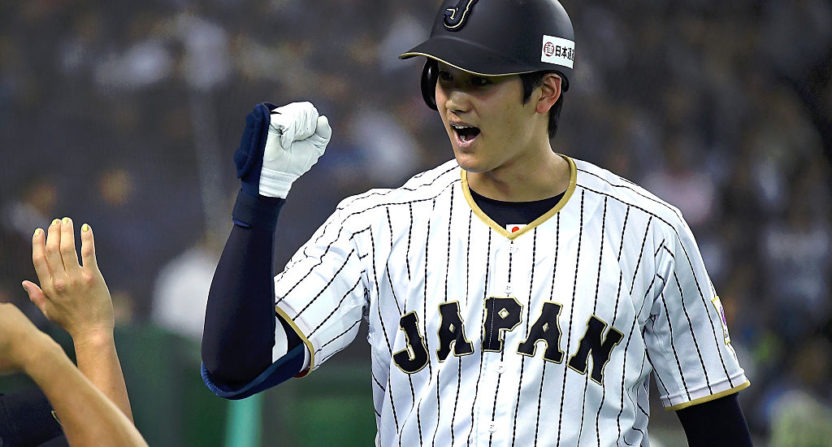According to multiple reports. potential two-way star Shohei Ohtani has cut his list down to seven teams.
The lucky 7, according to team sources, are mariners, padres, angels, dodgers, giants, rangers, cubs #ohtani
— Jon Heyman (@JonHeyman) December 4, 2017
The Dodgers and Mariners were seen as likely favorites heading into what’s become baseball’s version of a high-stakes recruiting battle, so it’s no surprise to see them make the cut. The Giants and Padres were also mentioned there, the Rangers have worked on Ohtani for years, and the Cubs have a front office perhaps best-suited to lay out a convincing argument. Oh, and the Angels have Mike Trout, and the Giants could maybe have Giancarlo Stanton.
Notably absent from that list: the Yankees and Red Sox; the Yankees are especially conspicuous, given they were considered by some to be favorites for Ohtani.
What do all seven finalists have in common? Only five are on the West Coast. Heading into the posting process, it was also assumed that American League clubs would have an advantage given their ability to offer Ohtani designated hitter at-bats in addition to a rotation slot. But there are more NL teams than AL in his final seven.
Maybe instead of focusing so much on American League and National League, it would have been better to focus on the Cactus League.
All seven finalists have their spring training complexes in Arizona, and considering one of the bullet points Ohtani asked for in the initial memorandum from prospective teams included spring training facilities, it’s reasonable to assume this plays a part.
Last week, Ben Lindbergh and Jeff Sullivan spent an episode of Effectively Wild breaking down what we could learn from the factors Ohtani requested. They spoke to former front office analyst Tony Blengino on the topic, and Blengino essentially predicted that Arizona spring training could play a big role:
One thing that probably might fly under the radar in this one: I really think training in Arizona is a big advantage of training in Flroida. And it’s because day to day life in spring training, you take a 45-minute drive at most to the ballpark you’re going to play at, and you’ve got the rest of your day. In Florida, you’re on I-4, or you’re on the Alligator Alley, or you’re in traffic, or you have a thunderstorm right at game time. In Arizona, it’s on autopilot.
Looking at Ohtani’s list of teams, there’s definitely a West Coast bias, so it makes sense that the two non-West Coast teams on the list have their spring training facilities in Arizona. For pitchers, that’s where they’ll spend six weeks or so before the season; if you’re Ohtani and you want to be out west as much as possible, that’s a big deal. (And that’s all in addition to Blengino’s point about quality of spring training life.)
It’s also a key point of sale for a team like the Cubs; if they’re battling uphill on the geographical issue, being able to point to the Arizona base in the spring is important. It puts the Cubs on even footing for the offseason and spring training, and during the season there’s obviously a restriction on a player’s time and freedom anyway.
Ohtani has a few weeks to decide on his destination, or whether he’ll sign at all, although his choice could come a lot sooner:
While we still don’t know much about where Ohtani will be signing, or if he’ll be signing at all, we do know that if he does end up signing with an MLB team, he’ll be reporting to Arizona in February.
